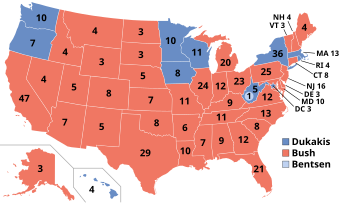
Back الانتخابات الرئاسية الأمريكية 1988 Arabic ھەڵبژاردنی سەرۆکایەتیی ویلایەتە یەکگرتووەکانی ئەمریکا (١٩٨٨) CKB Præsidentvalget i USA 1988 Danish Präsidentschaftswahl in den Vereinigten Staaten 1988 German Προεδρική εκλογή των Ηνωμένων Πολιτειών 1988 Greek 1988 United States presidential election English Elecciones presidenciales de Estados Unidos de 1988 Spanish انتخابات ریاستجمهوری ایالات متحده آمریکا (۱۹۸۸) Persian Yhdysvaltain presidentinvaalit 1988 Finnish Élection présidentielle américaine de 1988 French
| |||||||||||||||||||||||||||||
538 members of the Electoral College 270 electoral votes needed to win | |||||||||||||||||||||||||||||
|---|---|---|---|---|---|---|---|---|---|---|---|---|---|---|---|---|---|---|---|---|---|---|---|---|---|---|---|---|---|
| Turnout | 50.2%[1] | ||||||||||||||||||||||||||||
| |||||||||||||||||||||||||||||
 Presidential election results map. Red denotes states won by Bush/Quayle and blue denotes those won by Dukakis/Bentsen. Light blue is the electoral vote for Bentsen/Dukakis by a West Virginia faithless elector. Numbers indicate electoral votes cast by each state and the District of Columbia. | |||||||||||||||||||||||||||||
| |||||||||||||||||||||||||||||
The 1988 United States presidential election happened on November 8, 1988. George H. W. Bush, the Republican candidate and Vice President of the United States, won the election. He defeated the Democratic candidate, Governor Michael Dukakis of Massachusetts.
This presidential election was the first since 1948, as well as the most recent one to date, in which a political party won a third presidential election in a row. This also remains the most recent in which a candidate won over 400 electoral votes. Since the 1988 election, no candidate has managed to equal or surpass Bush's number of electoral votes won or popular vote percentage.
Bush ran an aggressive campaign taking advantage of a good economy, a stable international stage, and President Ronald Reagan's popularity. Meanwhile, Dukakis's campaign suffered from several miscues, including failure to defend from Bush's attacks. This allowed Bush to win with a substantial margin of the popular vote; while winning the Electoral College by a landslide.
Bush won the election by 426 electoral votes. Governor of Massachusetts Michael Dukakis got 111 electoral votes. Lloyd Bentsen got 1 electoral vote by a West Virginia faithless elector.
- ↑ "Dave Leip's Atlas of U.S. Presidential Elections". uselectionatlas.org. Retrieved October 21, 2012.
- ↑ A faithless Democratic elector voted for Bentsen for president and Dukakis for vice president

